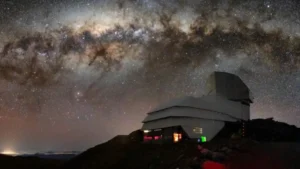Astronomers have found a huge deposit of water ice near the Mars equator. They had been aware of the deposits for decades but were unsure what they were made of. A new survey shows they are huge slabs of ice.
The European Space Agency (ESA) believes the ice contains the same amount of water as the Red Sea. A research team used the ESA’s Mars Express MARSIS radar to identify the ice water beneath the Medusae Fossae Formation.
“Excitingly, the radar signals match what we’d expect to see from layered ice and are similar to the signals we see from Mars’s polar caps, which we know to be very ice-rich,” Thomas Watters, lead author of the study, told IFLScience.

A map of the ice on Mars. Photo: Planetary Science Institution/Smithsonian Institution
Ice on the equator?
Researchers were shocked by the location of the ice.
“It’s as ludicrous on Mars as it would be on Earth, but that’s what the data is telling us,” Jim Green, NASA’s Director of Planetary Science, told a press conference.
At around 3.7km thick, the deposits are far beefier than the original data (from over a decade ago) suggested. If they melted, they could cover the planet in a layer of water over 1.5m deep. This suggests that Mars used to look completely different. This quantity of ice indicates there were once glaciers, lakes, and rivers.

The profile of ice deposits near Mars’ equator. Photo: CreSIS/KU/Smithsonian Institution
The old radar images showed relatively transparent layers. This meant they weren’t rock, but could have been dust, water, or ash. The new data not only shows that the deposit is water but also changes planetary scientists’ views on the Medusae Fossae Formation (MFF) altogether.
The MMF is a huge sedimentary deposit; it is approximately the same size as India. Previously, researchers thought it was most likely made from layers of dust.
Targets for future missions
“This latest analysis challenges our understanding of the Medusae Fossae Formation and raises as many questions as answers. How long ago did these ice deposits form and what was Mars like at that time? If confirmed to be water ice, these massive deposits would change our understanding of Mars’s climate history. Any reservoir of ancient water would be a fascinating target for human or robotic exploration,” Colin Wilson, ESA project scientist for the Mars Express explained.

The Medusae Fossae Formation. Photo: ESA
In one way, the water deposits are ideally located for future missions to Mars. Manned missions would have to be at lower latitudes because of the temperature, so it is incredibly encouraging that scientists have found water ice here.
However, at least for now, these particular deposits will be out of reach of humans landing on the red planet.
“Unfortunately, these MFF deposits are covered by hundreds of meters of dust, making them inaccessible for at least the next few decades,” Wilson said.






